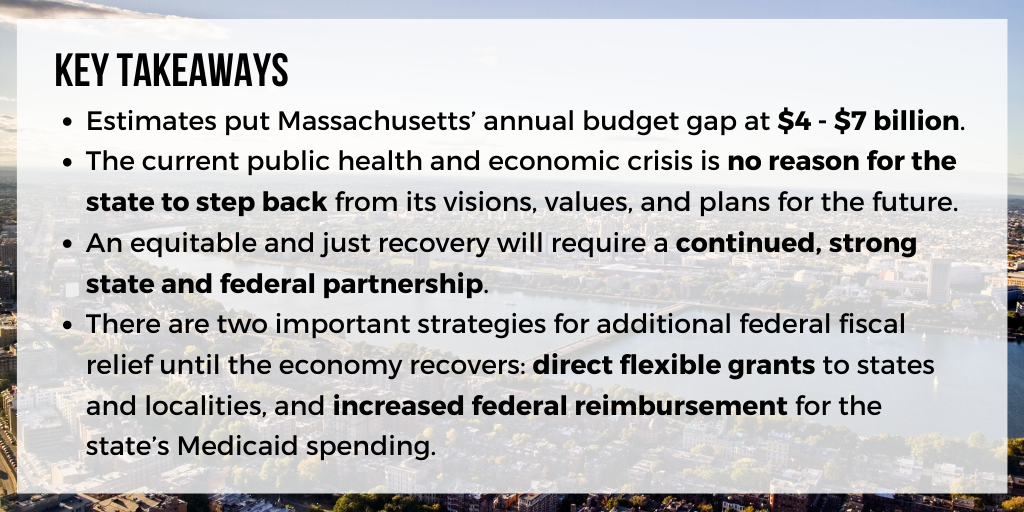For more on federal fiscal relief, read That’s A Relief Part I: Federal Fiscal Relief to Massachusetts in Recently-Passed Legislation and That’s A Relief Part II: Federal Fiscal Relief for Community Development in the CARES Act.

The Massachusetts state budget is the single piece of legislation each year that defines the state’s vision, values, and plan for the coming fiscal year. Over the course of the past two months, a public health emergency has quickly turned also into an economic emergency. And now, the scope of the state fiscal crisis that has come from this has only started to become clear.
Already, hundreds of thousands of families across Massachusetts are facing sudden and serious financial hardship due to the COVID-19 pandemic and the sharp economic downturn which resulted from it. The disruptions are profound. Massachusetts residents’ need for services from the state’s systems of support for housing, health care, food assistance and direct cash assistance have increased.[1] Schools are physically closed, and it’s not fully clear what will be involved in bringing students back safely. The state’s child care systems have been shut down, and yet never has the role of early education and care and its critical place in healthy child development, family stability, and its importance for working parents been more clear. Reopening child care will be complicated and require creative thinking and planning.
These new and previously-unanticipated needs have bumped up against the rapidly plummeting income tax, sales tax, gas tax and lottery revenues that the state typically uses to pay for these services. Few elements of the state’s revenue picture have been unharmed by the dramatic economic downturn over the past two months. And there is every indication that this downturn will be severe and long-lasting.
Cutting the state budget during a recession creates two problems. Budget cuts pull resources and supports away from the people who need it most when they need it most. State budget cuts during a recession also risk deepening and prolonging the recession.
The state budget sends billions of dollars to local communities; it pays for public sector workers who then have money in their pockets to spend in the community; it pays for state contracts that help keep hundreds of businesses and nonprofits afloat; it pays for benefits for residents so that they have money to spend on what they need.
In times such as these, austerity is not the best solution. This is not a time when the state would be made better off by budget cuts that would lay off teachers, first responders, health care providers, or that would cut housing, cash assistance to those most in need, food aid, or mental health services. Relying only on budget cuts to balance the state budget in times of need could create new and deeper problems for our Commonwealth.
Instead, these are the times for which government was created — to step in boldly when the public good is at risk. We have the resources to do what we need to do — we just need to harness them.
The state simply cannot get through this fiscal crisis alone.[2] Unlike the federal government, the Massachusetts state government must have a balanced budget every year. That means that regardless of the level of need in the Commonwealth, the budget cannot authorize spending beyond the amount of revenue available.
The federal government, on the other hand, has the power and authority to fund what is needed, regardless of whether revenues have temporarily fallen off. The federal government has in the past been a source of significant fiscal relief for the states, and it can be that again.
There are two questions: How should the federal government step in? How much does Massachusetts need?
The Role of the Federal Government
There is precedent for the federal government to step in. The significant federal investment that helped pull the country from the Great Depression in the 1930s transformed the relationship between the states and the federal government.[3] During the Great Recession of this century, the federal government, through the American Recovery and Reinvestment Act (ARRA), provided more than $5.5 billion (adjusted for inflation) in direct fiscal relief to Massachusetts that helped the state survive the fiscal crisis.[4] Nevertheless, in retrospect, analysts have noted that even this relief was not enough and ended too quickly.[5]
Since the onset of the novel coronavirus COVID-19 pandemic, Congress has stepped forward to provide a range of assistance to businesses, the health care sector, individuals, and state and local governments.[6] The four pieces of legislation have provided important support for the country. However, none of these yet provides significant or lasting fiscal relief for states.
Because this current economic downturn has been sharper and could be deeper than the Great Recession, it will be critical for the federal government to provide even more assistance to those who received support in the first rounds of COVID-19 legislation, assist those who have been largely or entirely left out of the laws passed so far, and help prevent the economic harm from getting even worse. Not only that, the need for these measures will go beyond just the public health emergency. They will be critical through the economic downturn and until the economy has fully recovered.
Federal Fiscal Relief: Direct Grants and Increased Medicaid Reimbursement
There are two important strategies for additional federal fiscal relief: direct flexible grants to states and localities, and an increase in the federal reimbursement rate for the state’s Medicaid spending. In the last recession, that is exactly how state budgetary relief came from ARRA: there was funding from what was called the State Fiscal Stabilization Fund that Massachusetts used primarily to bolster funding for education and for public safety, and there was an increase in the Medicaid reimbursement rate.
It is also important that state fiscal relief be flexible, and that it continue until the economy recovers. Looking back to the past two recessions, it took as many as six years for tax revenues in Massachusetts to return to their inflation-adjusted pre-recession levels.[7] Federal fiscal relief that is insufficient and that does not last long enough would not protect against reductions in state spending that could further deepen the recession.
Federal Legislation — Grants to States and Localities
During the Great Recession, ARRA provided funding for the states through direct flexible grants (known as the State Fiscal Stabilization Fund). Massachusetts received (inflation-adjusted) $1.3 billion from these funds which the state used to prevent even deeper cuts to K-12, higher education, and public safety.[8]
The recent federal CARES Act includes direct grants to states and localities through the Coronavirus Relief Fund. This fund will bring about $2.67 billion to Massachusetts with approximately $2.46 billion for use by the state government, and $212 million available for Boston and Plymouth County.[9] However, guidance from the U.S. Department of the Treasury explicitly states this funding cannot be used to replace lost state revenues.[10] That means this funding cannot protect the state from deep cuts to state spending.
Federal Legislation — Increased Medicaid Reimbursement
One of the most efficient ways for the federal government to provide fiscal relief quickly to the states is to increase the reimbursement rate for a state’s Medicaid spending (Federal Medical Assistance Percentage or “FMAP”). Since the base Massachusetts FMAP rate is 50%, when Massachusetts spends on Medicaid (MassHealth), the federal government in most instances reimburses the state for half its spending.
Increasing the FMAP is a simple mechanism for distributing federal money. It requires no additional grant approvals or new administrative systems. The increased FMAP in Massachusetts goes into the General Fund where it is immediately available to disburse into the economy.
During the Great Recession, Massachusetts received more than $4.2 billion (adjusted for inflation) in increased FMAP reimbursement for its spending on MassHealth to help address the state’s budget crisis at that time.[11]
Not only does an increased FMAP provide direct fiscal relief and help hold off state budget cuts, it immediately helps keep down the state’s cost of maintaining and expanding health care coverage as needed. This, of course, is a critical component of the state’s response to the pandemic and to the economic downturn. Unemployment has been increasing meaning that residents are at risk of losing employer-sponsored health care. An increased FMAP that reduces the state’s cost of providing Medicaid helps maintain robust MassHealth coverage to fill these growing health insurance coverage gaps. An increased FMAP also holds down the costs to the state for the MassHealth home- and community-based services that allow vulnerable elders and persons with disabilities to remain living safely in the community rather than in larger congregate and institutional settings.
The recent federal Families First Act increased FMAP by 6.2 percentage points. However, this increased amount stays in place only through the end of the quarter in which there is a declared public health emergency. Families First also did not extend the increased FMAP to enrollees eligible for the program under the “expansion” rules of the Affordable Care Act.[12] This Act will bring in needed federal fiscal relief, but only about $1.1 billion.[13]
A more effective FMAP increase would resemble the FMAP increase enacted under ARRA. There could be the base increase (even starting with the existing 6.2 percentage points increase) coupled with additional incremental increases based on some economic metric such as the increase in the unemployment rate. These FMAP increases would then stay in place until the economic metrics returned to an established baseline. This would ensure sufficient fiscal relief through the economic downturn so that state budgets wouldn’t be forced to cut essential spending just when that spending would be needed most to move into recovery. This increase should also apply to all MassHealth spending, including spending for “expansion” programs.
How Much Fiscal Relief Does Massachusetts Need?
There are two sides to the fiscal gap created by the pandemic and economic crisis. There are increases in need — both due to increased health and public health needs, and due to increased needs for basic supports resulting from unemployment and economic dislocation. That’s the spending side of the state budget balance.
On the revenue side of the budget equation, already the state is seeing decreases in tax revenues due to income losses and the economic shutdown.[14]
It’s not just tax losses that are affecting the state’s budget. With local stores shut and the casinos shuttered, there are steep drops in the non-tax revenues that the state has counted on from the lottery and gambling.
There are estimates that nationally, the collective budget gaps faced by states may be as much as $650 billion.[15] There are estimates that in Massachusetts alone, the Fiscal Year 2021 budget gap may be anywhere from $4 — $7 billion.[16]
The challenges of the moment are no reason for Massachusetts to take a fundamental step back from its vision, its values, and its plans for the future. We must press for the federal government to do more to support a strong, equitable and just recovery here in Massachusetts.
***
ENDNOTES
[1]Gabrielle Emanuel, “Newly Unemployed Seek Health Insurance Amid Pandemic,” WGBH (April 15, 2020), https://www.wgbh.org/news/local-news/2020/04/15/newly-unemployed-seek-health-insurance-amidst-pandemic and Chris Lisinski, “Mass. Residents Turning to Public Assistance Programs,” State House News Service (April 8, 2020), https://www.statehousenews.com/email/a/2020723?key=f1ceac.
[2]See MassBudget’s discussion of the use of the Rainy Day Fund for short-term, one-time immediate needs as well as potential ongoing sources of progressive tax revenue summarized in “Amid plummeting state tax collections, the Commonwealth has options” at https://medium.com/massbudget/amid-plummeting-state-tax-collections-the-commonwealth-has.
[3]See Ronald Snell, “State Finance in the Great Depression,” National Conference of State Legislatures, 2009, p. 8, at https://www.ncsl.org/Portals/1/documents/fiscal/STATEFINANCEGREATDEPRESSION.pdfoptions-4b9881548213.
[4]Author’s calculations based on MassBudget budget data and on revenue data from Mass. Office of the State Comptroller at http://cthrurevenue.mass.gov/.
[5]See, for example, Chad Stone, “Fiscal Stimulus Needed to Fight Recessions: Lessons From the Great Recession,” Center on Budget and Policy Priorities, April 16, 2020, at https://www.cbpp.org/research/economy/fiscal-stimulus-needed-to-fight-recessions.
[6]For a discussion of some of this legislation, see compilation of Mass. Budget and Policy Center reports at https://massbudget.org/covid19.php and blog posts at https://medium.com/@MassBudget.
[7]https://massbudget.org/reports/pdf/MFR%20Testimony%204.14.pdf.
[8]Author’s calculations based on MassBudget budget data and on revenue data from Mass. Office of the State Comptroller at http://cthrurevenue.mass.gov/.
[9]About $1.0 billion of the total was set aside for cities and counties with populations over 500,000. See Nancy Wagman, “That’s A Relief Part I: Federal Fiscal Relief to Massachusetts in Recently-Passed Legislation”, Mass. Budget and Policy Center, April 15, 2020, at https://medium.com/massbudget/thats-a-relief-federal-fiscal-relief-to-massachusetts-in-recently-passed-legislation-67c1c5f72e97. Only Boston and Plymouth County certified for these local funds, leaving the remainder for the state to allocate. See https://home.treasury.gov/system/files/136/Payments-to-States-and-Units-of-Local-Government.pdf.
[11]Author’s calculations based on MassBudget budget data and on revenue data from Mass. Office of the State Comptroller at http://cthrurevenue.mass.gov/.
[12]https://ccf.georgetown.edu/wp-content/uploads/2020/03/Families-First-Final-3.30-V2.pdf.
[13]See Nancy Wagman, “That’s A Relief Part I: Federal Fiscal Relief to Massachusetts in Recently-Passed Legislation”, Mass. Budget and Policy Center, April 15, 2020, at https://medium.com/massbudget/thats-a-relief-federal-fiscal-relief-to-massachusetts-in-recently-passed-legislation-67c1c5f72e97.
[14]https://www.mass.gov/doc/april-2020-mid-month-revenue-report/download.
[15]Chye-Ching Huang, Chad Stone, Katie Windham, Jennifer Beltran, “Putting the Size of the Needed COVID-19 Fiscal Response in Perspective,” Center on Budget and Policy Priorities, May 4, 2020, at https://www.cbpp.org/research/federal-budget/putting-the-size-of-the-needed-covid-19-fiscal-response-in-perspective.
[16]Center on Budget and Policy Priorities, “States Grappling With Hit to Tax Collections,” May 11, 2020, at https://www.cbpp.org/research/state-budget-and-tax/states-grappling-with-hit-to-tax-collections.





